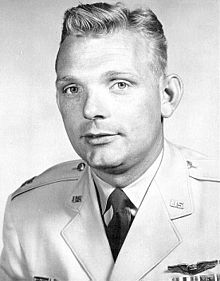7 September 1956 – The Bell X-2 research aircraft is flown by Captain Iven C. Kincheloe to a new altitude record of 126,200 ft (38,466 m)
 Iven Carl “Kinch” Kincheloe Jr. (July 2, 1928 – July 26, 1958).
Iven Carl “Kinch” Kincheloe Jr. (July 2, 1928 – July 26, 1958).
Upon graduation from college, Kincheloe received his commission as a second lieutenant in the U.S. Air Force and entered flight training. After earning his pilot wings in August 1950, he spent a year as a test pilot, flying the F-86E at Edwards Air Force Base, California, was promoted to First Lieutenant, and transferred to Korea in September 1951.
During the war, he was assigned to the 25th Fighter-Interceptor Squadron, he flew F-80s on thirty combat missions and F-86s on 101 combat missions, downing five MiG-15s (becoming an ace and earning the Silver Star) before returning to the U.S. in May 1952. At this time, he had reached the rank of captain.
Post-war career
After the war, Kincheloe was a gunnery instructor at Nellis Air Force Base outside Las Vegas, Nevada, then resumed his activity as a test pilot (subsequent to his prior flight test activities associated with the F-86E), graduating in December 1954 from the Empire Test Pilots’ School at Farnborough, England. He participated in the testing of the Century Series of fighter aircraft (F-100 Super Sabre, F-101 Voodoo, F-102 Delta Dagger, F-104 Starfighter, F-105 Thunderchief, and F-106 Delta Dart).
In the mid-1950s, Kincheloe joined the Bell X-2 program and on September 7, 1956,[6] flew at more than 2,000 mph (3,220 km/h) and to a height of 126,200 feet (38,470 m) (some sources list 126,500), the first flight ever above 100,000 feet (30,480 m). For this, he was nicknamed “America’s No. 1 Spaceman”. He was awarded the Mackay Trophy for 1956 for the flight.
The X-2 program was halted three weeks later after a fatal crash resulted in the death of Mel Apt in a flight in which Apt became the first person to exceed Mach 3. Kincheloe was later selected as one of the first three pilots in the next rocket-powered aircraft program, the X-15, and would have been part of the Man in Space Soonest project.
(1) Wikipedia
